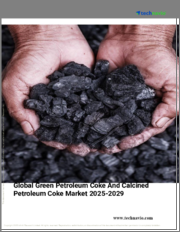
|
시장보고서
상품코드
1667876
Pet Coke to Chemicals 시장 : 세계 산업 규모, 점유율, 동향, 기회, 예측, 유형별, 용도별, 지역별, 경쟁별(2020-2030년)Pet Coke to Chemicals Market - Global Industry Size, Share, Trends, Opportunity, and Forecast, Segmented By Type, By Application, By Region and Competition, 2020-2030F |
||||||
Pet Coke to Chemicals 세계 시장은 2024년 46억 달러로 평가되었고, 예측 기간 동안 안정적인 성장세를 보이며 2024년부터 2030년까지 4.08%의 연평균 복합 성장률(CAGR)을 보일 것으로 예상됩니다.
시장 확대에는 몇 가지 요인이 있습니다. 전 세계 건설 활동의 회복은 건축자재 및 건설 공정에 널리 사용되는 PET 코크스 기반 화학제품에 대한 수요 증가로 이어지고 있습니다. 또한, 특히 신흥국의 전력 부문에서 펫코크스 소비가 증가하면서 발전 및 관련 산업에 필수적인 펫코크스 유래 화학물질에 대한 수요가 증가하고 있습니다. 건설 산업의 성장은 시멘트 수요를 증가시켜 제조 산업에서 펫코크스 유래 화학제품의 필요성을 높이고 있기 때문입니다. 또한, 세계 인구 증가와 경제 활동의 확대로 인해 다양한 분야에서 에너지 수요가 증가하고 있으며, 이에 따라 에너지 생산의 주요 원료인 PET 코크스 생산량이 증가하고 있습니다. PET 코크스를 화학제품으로 전환하는 것은 환경에 미치는 영향을 최소화하면서 효율성을 높이는 지속 가능한 솔루션으로 점점 더 많은 관심을 받고 있습니다. 이에 따라 펫코크스-화학제품 부문 제조업체들은 수요 증가에 대응하기 위해 생산 능력 확대에 주력하고 있습니다.
| 시장 개요 | |
|---|---|
| 예측 기간 | 2026-2030년 |
| 시장 규모 : 2024년 | 46억 달러 |
| 시장 규모 : 2030년 | 58억 6,000만 달러 |
| CAGR(2025-2030년) | 4.08% |
| 급성장 부문 | 프로파일렌 |
| 최대 시장 | 아시아태평양 |
시장 성장 촉진요인
화학제품 수요 증가
주요 시장 과제
원료 공급의 불안정성
주요 시장 동향
지속 가능한 관행으로의 전환
목차
제1장 개요
제2장 조사 방법
제3장 주요 요약
제4장 세계의 Pet Coke to Chemicals 시장 전망
- 시장 규모와 예측
- 금액별
- 시장 점유율과 예측
- 유형별(프로파일렌, 에틸렌, 메탄올, 방향족)
- 용도별(시멘트, 전력, 제련, 비료, 폴리머)
- 지역별
- 기업별(2024년)
- 시장 맵
- 유형별
- 용도별
- 지역별
제5장 아시아태평양의 Pet Coke to Chemicals 시장 전망
- 시장 규모와 예측
- 금액별
- 시장 점유율과 예측
- 아시아태평양 : 국가별 분석
- 중국
- 인도
- 호주
- 일본
- 한국
제6장 유럽의 Pet Coke to Chemicals 시장 전망
- 시장 규모와 예측
- 시장 점유율과 예측
- 유럽 : 국가별 분석
- 독일
- 스페인
- 이탈리아
- 영국
제7장 북미의 Pet Coke to Chemicals 시장 전망
- 시장 규모와 예측
- 시장 점유율과 예측
- 북미 : 국가별 분석
- 멕시코
- 캐나다
제8장 남미의 Pet Coke to Chemicals 시장 전망
- 시장 규모와 예측
- 시장 점유율과 예측
- 남미 : 국가별 분석
- 아르헨티나
- 콜롬비아
제9장 중동 및 아프리카의 Pet Coke to Chemicals 시장 전망
- 시장 규모와 예측
- 시장 점유율과 예측
- 중동 및 아프리카 : 국가별 분석
- 사우디아라비아
- 아랍에미리트(UAE)
- 이집트
제10장 시장 역학
- 성장 촉진요인
- 과제
제11장 시장 동향과 발전
- 제품 출시
- 인수합병(M&A)
제12장 세계의 Pet Coke to Chemicals 시장 : SWOT 분석
제13장 Porter의 Five Forces 분석
- 산업내 경쟁
- 신규 참여 가능성
- 공급업체의 힘
- 고객의 힘
- 대체품의 위협
제14장 경쟁 구도
- BP Plc
- Essar Oil Limited
- Reliance Industries Limited
- Oxbow Carbon LLC
- Repsol S.A
- ExxonMobil Corporation
- Indian Oil Corporation Limited
- Sinopec Corporation
- Chevron Corporation
- Valero Energy Corporation
제15장 전략적 제안
제16장 리서치사에 대해 & 면책사항
LSH 25.04.04The Global Petroleum Coke (Pet Coke) to Chemicals Market was valued at USD 4.60 billion in 2024 and is projected to experience steady growth throughout the forecast period, with a compound annual growth rate (CAGR) of 4.08% from 2024 to 2030. Several factors are contributing to the market's expansion. The global resurgence in construction activities has led to increased demand for pet coke-based chemicals, which are widely used in construction materials and processes. Furthermore, the rising consumption of pet coke in the power sector, particularly in emerging economies, is driving demand for pet coke-derived chemicals, which are essential in power generation and associated industries. The expanding use of pet coke-based chemicals in cement production is another significant driver, as the growth of the construction industry boosts cement demand, thereby increasing the need for pet coke-based chemicals in manufacturing. Additionally, the growing global population and expanding economic activities are escalating energy demands across various sectors, resulting in higher pet coke production, as it is a key feedstock in energy generation. Converting pet coke into chemicals is increasingly seen as a sustainable solution that enhances its efficiency while minimizing environmental impact. As a result, manufacturers in the pet coke to chemicals sector are focusing on expanding their production capacities to meet rising demand.
| Market Overview | |
|---|---|
| Forecast Period | 2026-2030 |
| Market Size 2024 | USD 4.60 Billion |
| Market Size 2030 | USD 5.86 Billion |
| CAGR 2025-2030 | 4.08% |
| Fastest Growing Segment | Propylene |
| Largest Market | Asia Pacific |
Key Market Drivers
Growing Demand for Chemicals
The rising demand for chemicals is a primary driver in the global petroleum coke (pet coke) to chemicals market. Pet coke, a carbon-rich solid material produced during oil refining, is increasingly utilized as a feedstock in chemical manufacturing. This trend is fueled by the growing demand for chemical products across various industries such as plastics, fertilizers, synthetic fibers, and specialty chemicals. Pet coke is a cost-effective and readily available feedstock that supports the production of syngas (synthesis gas), hydrogen, ammonia, methanol, and other chemicals. The global chemical industry, valued at approximately $4.7 trillion in 2023, is expanding rapidly due to urbanization, industrialization, and population growth, creating greater demand for feedstocks like pet coke. The shift towards pet coke as a feedstock is driven by its economic advantages over traditional sources like naphtha and natural gas, particularly in regions with limited access to affordable natural gas. Major end-use sectors for pet coke-derived chemicals include plastics and polymers, with methanol and ethylene serving as key building blocks for polyethylene, polypropylene, and other polymers.
Key Market Challenges
Volatility in Feedstock Availability
Petroleum coke plays a critical role as a feedstock in the production of various chemicals, but fluctuations in its availability and quality can significantly impact the supply of pet coke-based chemicals. This volatility is primarily driven by fluctuations in the costs of feedstock and crude oil, which directly affect the price of pet coke. Prices can vary significantly, ranging from under USD 25 per ton to USD 60-72 per metric ton, creating challenges for manufacturers who struggle to predict costs and plan production efficiently. Such price instability can also disrupt the supply chain, adding further complexity to market dynamics.
Key Market Trends
Shift Toward Sustainable Practices
As a byproduct of oil refining, petroleum coke is an essential raw material in chemical production. However, concerns over its environmental impact, including potential contributions to greenhouse gas emissions and air pollution, have led the industry to focus on more sustainable practices. Manufacturers are increasingly investing in advanced technologies to convert pet coke into chemicals in a more environmentally responsible way. One such method is carbon capture and storage (CCS), which captures carbon dioxide emissions generated during pet coke production and stores them underground, effectively reducing the overall carbon footprint of the industry.
Key Market Players
- BP Plc
- Essar Oil Limited
- Reliance Industries Limited
- Oxbow Carbon LLC
- Repsol S.A.
- ExxonMobil Corporation
- Indian Oil Corporation Limited
- Sinopec Corporation
- Chevron Corporation
- Valero Energy Corporation
Report Scope:
The Global Pet Coke to Chemicals Market has been segmented into the following categories:
By Type:
- Propylene
- Ethylene
- Methanol
- Aromatics
By Application:
- Cement
- Power
- Smelting
- Fertilizers
- Polymer
By Region:
- North America
- United States
- Canada
- Mexico
- Europe
- France
- United Kingdom
- Italy
- Germany
- Spain
- Asia-Pacific
- China
- India
- Japan
- Australia
- South Korea
- South America
- Brazil
- Argentina
- Colombia
- Middle East & Africa
- South Africa
- Saudi Arabia
- UAE
- Egypt
Competitive Landscape
This section includes detailed analysis of key market players in the global pet coke to chemicals market.
Available Customizations:
TechSci Research offers customizations of this report according to specific business requirements, including the following options:
- Detailed company profiles for additional market players (up to five).
Table of Contents
1. Product Overview
- 1.1. Market Definition
- 1.2. Scope of the Market
- 1.2.1. Markets Covered
- 1.2.2. Years Considered for Study
- 1.2.3. Key Market Segmentations
2. Research Methodology
- 2.1. Objective of the Study
- 2.2. Baseline Methodology
- 2.3. Key Industry Partners
- 2.4. Major Association and Secondary Sources
- 2.5. Forecasting Methodology
- 2.6. Data Triangulation & Validation
- 2.7. Assumptions and Limitations
3. Executive Summary
- 3.1. Overview of the Market
- 3.2. Overview of Key Market Segmentations
- 3.3. Overview of Key Market Players
- 3.4. Overview of Key Regions/Countries
- 3.5. Overview of Market Drivers, Challenges, Trends
4. Global Pet Coke to Chemicals Market Outlook
- 4.1. Market Size & Forecast
- 4.1.1. By Value
- 4.2. Market Share & Forecast
- 4.2.1. By Type (Propylene, Ethylene, Methanol, Aromatics)
- 4.2.2. By Application (Cement, Power, Smelting, Fertilizers, Polymer)
- 4.2.3. By Region
- 4.2.4. By Company (2024)
- 4.3. Market Map
- 4.3.1. By Type
- 4.3.2. By Application
- 4.3.3. By Region
5. Asia Pacific Pet Coke to Chemicals Market Outlook
- 5.1. Market Size & Forecast
- 5.1.1. By Value
- 5.2. Market Share & Forecast
- 5.2.1. By Type
- 5.2.2. By Application
- 5.2.3. By Country
- 5.3. Asia Pacific: Country Analysis
- 5.3.1. China Pet Coke to Chemicals Market Outlook
- 5.3.1.1. Market Size & Forecast
- 5.3.1.1.1. By Value
- 5.3.1.2. Market Share & Forecast
- 5.3.1.2.1. By Type
- 5.3.1.2.2. By Application
- 5.3.1.1. Market Size & Forecast
- 5.3.2. India Pet Coke to Chemicals Market Outlook
- 5.3.2.1. Market Size & Forecast
- 5.3.2.1.1. By Value
- 5.3.2.2. Market Share & Forecast
- 5.3.2.2.1. By Type
- 5.3.2.2.2. By Application
- 5.3.2.1. Market Size & Forecast
- 5.3.3. Australia Pet Coke to Chemicals Market Outlook
- 5.3.3.1. Market Size & Forecast
- 5.3.3.1.1. By Value
- 5.3.3.2. Market Share & Forecast
- 5.3.3.2.1. By Type
- 5.3.3.2.2. By Application
- 5.3.3.1. Market Size & Forecast
- 5.3.4. Japan Pet Coke to Chemicals Market Outlook
- 5.3.4.1. Market Size & Forecast
- 5.3.4.1.1. By Value
- 5.3.4.2. Market Share & Forecast
- 5.3.4.2.1. By Type
- 5.3.4.2.2. By Application
- 5.3.4.1. Market Size & Forecast
- 5.3.5. South Korea Pet Coke to Chemicals Market Outlook
- 5.3.5.1. Market Size & Forecast
- 5.3.5.1.1. By Value
- 5.3.5.2. Market Share & Forecast
- 5.3.5.2.1. By Type
- 5.3.5.2.2. By Application
- 5.3.5.1. Market Size & Forecast
- 5.3.1. China Pet Coke to Chemicals Market Outlook
6. Europe Pet Coke to Chemicals Market Outlook
- 6.1. Market Size & Forecast
- 6.1.1. By Value
- 6.2. Market Share & Forecast
- 6.2.1. By Type
- 6.2.2. By Application
- 6.2.3. By Country
- 6.3. Europe: Country Analysis
- 6.3.1. France Pet Coke to Chemicals Market Outlook
- 6.3.1.1. Market Size & Forecast
- 6.3.1.1.1. By Value
- 6.3.1.2. Market Share & Forecast
- 6.3.1.2.1. By Type
- 6.3.1.2.2. By Application
- 6.3.1.1. Market Size & Forecast
- 6.3.2. Germany Pet Coke to Chemicals Market Outlook
- 6.3.2.1. Market Size & Forecast
- 6.3.2.1.1. By Value
- 6.3.2.2. Market Share & Forecast
- 6.3.2.2.1. By Type
- 6.3.2.2.2. By Application
- 6.3.2.1. Market Size & Forecast
- 6.3.3. Spain Pet Coke to Chemicals Market Outlook
- 6.3.3.1. Market Size & Forecast
- 6.3.3.1.1. By Value
- 6.3.3.2. Market Share & Forecast
- 6.3.3.2.1. By Type
- 6.3.3.2.2. By Application
- 6.3.3.1. Market Size & Forecast
- 6.3.4. Italy Pet Coke to Chemicals Market Outlook
- 6.3.4.1. Market Size & Forecast
- 6.3.4.1.1. By Value
- 6.3.4.2. Market Share & Forecast
- 6.3.4.2.1. By Type
- 6.3.4.2.2. By Application
- 6.3.4.1. Market Size & Forecast
- 6.3.5. United Kingdom Pet Coke to Chemicals Market Outlook
- 6.3.5.1. Market Size & Forecast
- 6.3.5.1.1. By Value
- 6.3.5.2. Market Share & Forecast
- 6.3.5.2.1. By Type
- 6.3.5.2.2. By Application
- 6.3.5.1. Market Size & Forecast
- 6.3.1. France Pet Coke to Chemicals Market Outlook
7. North America Pet Coke to Chemicals Market Outlook
- 7.1. Market Size & Forecast
- 7.1.1. By Value
- 7.2. Market Share & Forecast
- 7.2.1. By Type
- 7.2.2. By Application
- 7.2.3. By Country
- 7.3. North America: Country Analysis
- 7.3.1. United States Pet Coke to Chemicals Market Outlook
- 7.3.1.1. Market Size & Forecast
- 7.3.1.1.1. By Value
- 7.3.1.2. Market Share & Forecast
- 7.3.1.2.1. By Type
- 7.3.1.2.2. By Application
- 7.3.1.1. Market Size & Forecast
- 7.3.2. Mexico Pet Coke to Chemicals Market Outlook
- 7.3.2.1. Market Size & Forecast
- 7.3.2.1.1. By Value
- 7.3.2.2. Market Share & Forecast
- 7.3.2.2.1. By Type
- 7.3.2.2.2. By Application
- 7.3.2.1. Market Size & Forecast
- 7.3.3. Canada Pet Coke to Chemicals Market Outlook
- 7.3.3.1. Market Size & Forecast
- 7.3.3.1.1. By Value
- 7.3.3.2. Market Share & Forecast
- 7.3.3.2.1. By Type
- 7.3.3.2.2. By Application
- 7.3.3.1. Market Size & Forecast
- 7.3.1. United States Pet Coke to Chemicals Market Outlook
8. South America Pet Coke to Chemicals Market Outlook
- 8.1. Market Size & Forecast
- 8.1.1. By Value
- 8.2. Market Share & Forecast
- 8.2.1. By Type
- 8.2.2. By Application
- 8.2.3. By Country
- 8.3. South America: Country Analysis
- 8.3.1. Brazil Pet Coke to Chemicals Market Outlook
- 8.3.1.1. Market Size & Forecast
- 8.3.1.1.1. By Value
- 8.3.1.2. Market Share & Forecast
- 8.3.1.2.1. By Type
- 8.3.1.2.2. By Application
- 8.3.1.1. Market Size & Forecast
- 8.3.2. Argentina Pet Coke to Chemicals Market Outlook
- 8.3.2.1. Market Size & Forecast
- 8.3.2.1.1. By Value
- 8.3.2.2. Market Share & Forecast
- 8.3.2.2.1. By Type
- 8.3.2.2.2. By Application
- 8.3.2.1. Market Size & Forecast
- 8.3.3. Colombia Pet Coke to Chemicals Market Outlook
- 8.3.3.1. Market Size & Forecast
- 8.3.3.1.1. By Value
- 8.3.3.2. Market Share & Forecast
- 8.3.3.2.1. By Type
- 8.3.3.2.2. By Application
- 8.3.3.1. Market Size & Forecast
- 8.3.1. Brazil Pet Coke to Chemicals Market Outlook
9. Middle East and Africa Pet Coke to Chemicals Market Outlook
- 9.1. Market Size & Forecast
- 9.1.1. By Value
- 9.2. Market Share & Forecast
- 9.2.1. By Type
- 9.2.2. By Application
- 9.2.3. By Country
- 9.3. MEA: Country Analysis
- 9.3.1. South Africa Pet Coke to Chemicals Market Outlook
- 9.3.1.1. Market Size & Forecast
- 9.3.1.1.1. By Value
- 9.3.1.2. Market Share & Forecast
- 9.3.1.2.1. By Type
- 9.3.1.2.2. By Application
- 9.3.1.1. Market Size & Forecast
- 9.3.2. Saudi Arabia Pet Coke to Chemicals Market Outlook
- 9.3.2.1. Market Size & Forecast
- 9.3.2.1.1. By Value
- 9.3.2.2. Market Share & Forecast
- 9.3.2.2.1. By Type
- 9.3.2.2.2. By Application
- 9.3.2.1. Market Size & Forecast
- 9.3.3. UAE Pet Coke to Chemicals Market Outlook
- 9.3.3.1. Market Size & Forecast
- 9.3.3.1.1. By Value
- 9.3.3.2. Market Share & Forecast
- 9.3.3.2.1. By Type
- 9.3.3.2.2. By Application
- 9.3.3.1. Market Size & Forecast
- 9.3.4. Egypt Pet Coke to Chemicals Market Outlook
- 9.3.4.1. Market Size & Forecast
- 9.3.4.1.1. By Value
- 9.3.4.2. Market Share & Forecast
- 9.3.4.2.1. By Type
- 9.3.4.2.2. By Application
- 9.3.4.1. Market Size & Forecast
- 9.3.1. South Africa Pet Coke to Chemicals Market Outlook
10. Market Dynamics
- 10.1. Drivers
- 10.2. Challenges
11. Market Trends & Developments
- 11.1. Recent Developments
- 11.2. Product Launches
- 11.3. Mergers & Acquisitions
12. Global Pet Coke to Chemicals Market: SWOT Analysis
13. Porter's Five Forces Analysis
- 13.1. Competition in the Industry
- 13.2. Potential of New Entrants
- 13.3. Power of Suppliers
- 13.4. Power of Customers
- 13.5. Threat of Substitute Product
14. Competitive Landscape
- 14.1. BP Plc
- 14.1.1. Business Overview
- 14.1.2. Company Snapshot
- 14.1.3. Products & Services
- 14.1.4. Financials (In case of listed)
- 14.1.5. Recent Developments
- 14.1.6. SWOT Analysis
- 14.2. Essar Oil Limited
- 14.3. Reliance Industries Limited
- 14.4. Oxbow Carbon LLC
- 14.5. Repsol S.A
- 14.6. ExxonMobil Corporation
- 14.7. Indian Oil Corporation Limited
- 14.8. Sinopec Corporation
- 14.9. Chevron Corporation
- 14.10. Valero Energy Corporation



















